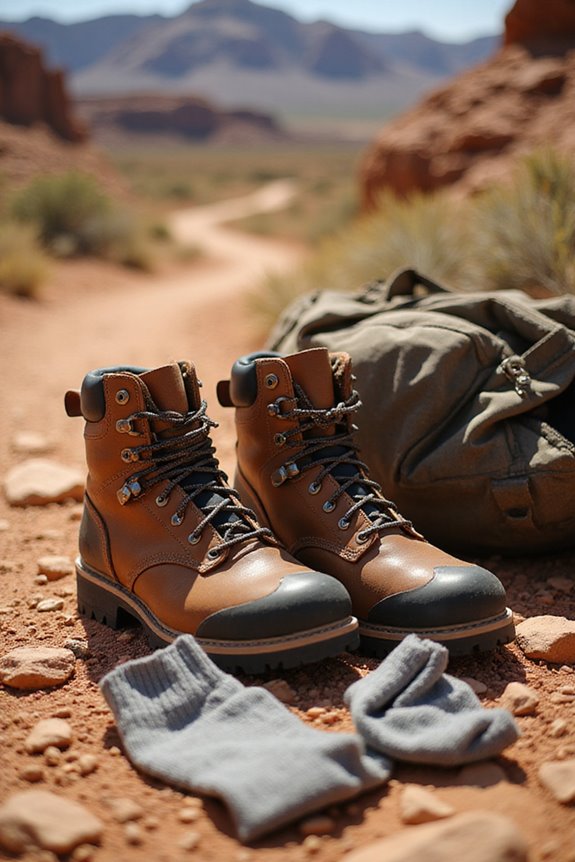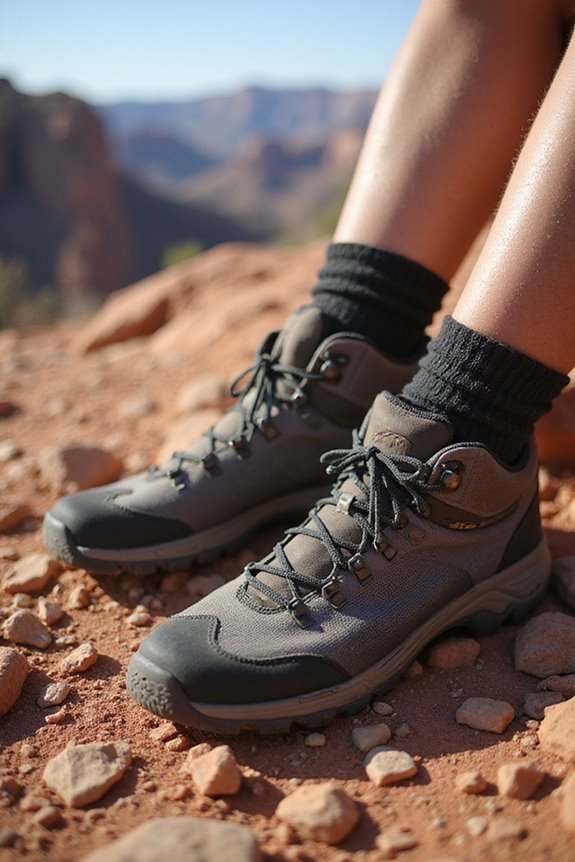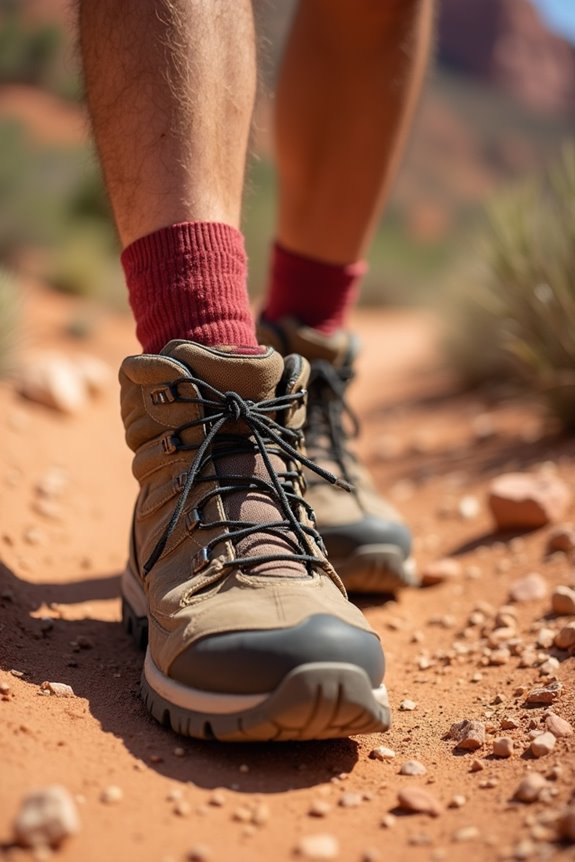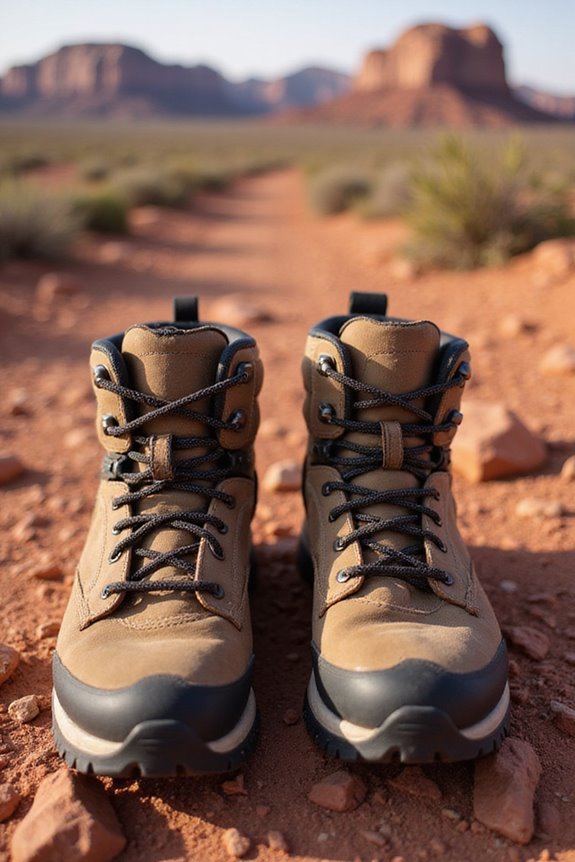When we’re gearing up for a hike, packing for our boots is vital! Make sure to have the right footwear—think sturdy, waterproof boots for tough trails, and breathable ones for three-season hikes. Don’t forget moisture-wicking socks to keep those blisters at bay. A foot care kit is a game changer for any long trek, too! Oh, and of course, toss in some waterproofing supplies! Stick around, and we’ll equip you with even more essential hiking tips!
Key Takeaways
- Pack moisture-wicking socks made of merino wool or synthetic fibers to prevent blisters and keep your feet dry.
- Include moleskin pads and adhesive bandages in your foot care kit to address blisters or cuts promptly.
- Bring waterproofing supplies, such as wax treatments or silicone sprays, to maintain your hiking boots’ waterproof features.
- Carry trekking poles for added stability and support on uneven terrain during your hike.
- Ensure you have a gentle brush to clean dirt and grit from boots to preserve their waterproofing.
Essential Footwear Types for Hiking
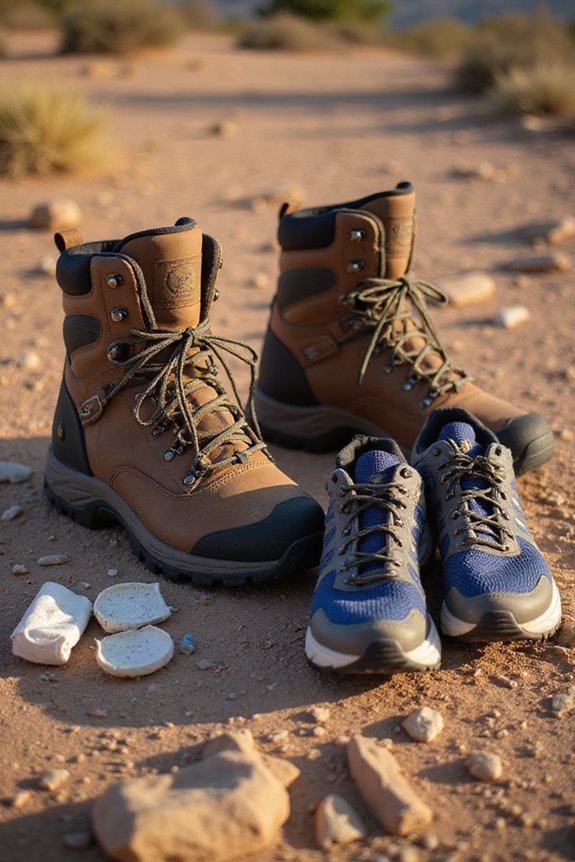
When you’re gearing up for a hiking adventure, it’s essential to choose the right footwear—after all, our feet are our trusty companions on the trail! For robust support, we often turn to full-grain leather boots, perfect for tough, snowy terrains, while hybrid options offer the best of breathability and weight for those three-season hikes. Mid-cut hiking boots strike that sweet balance between support and versatility on varying trails. Don’t forget to contemplate your foot arch; it plays a huge role in choosing the right boot materials! Whether we choose waterproof designs for soggy paths or lightweight shoes for well-maintained trails, let’s embrace the freedom that comes with comfortable, prepared feet for our incredible adventures. Many hikers find that Merrell Moab 3 models provide exceptional cushioning with their COMFORTBASE footbed technology, making them ideal for long-distance treks.
The Importance of Proper Sock Selection
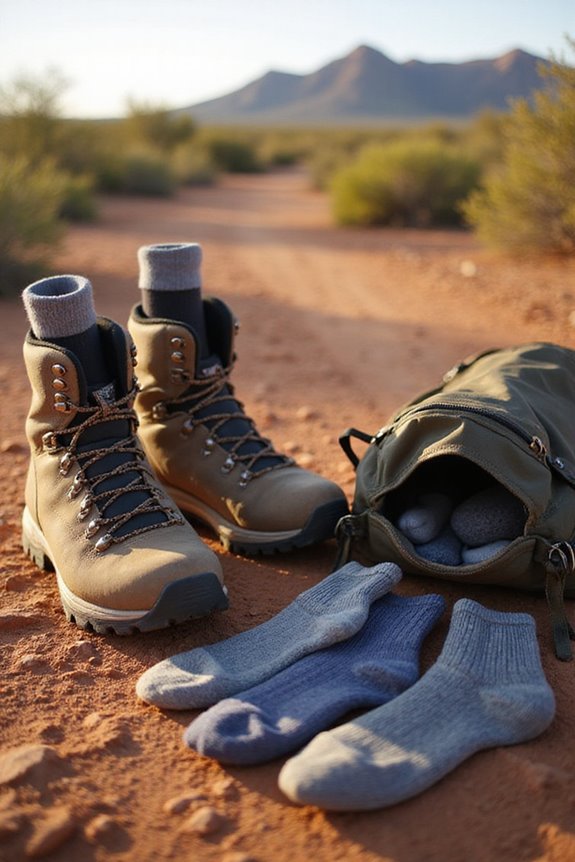
Choosing the right socks for our hiking adventures can make all the difference between feeling like a super conqueror of mountains and the defeated victim of blisters. The sock material matters—merino wool is our go-to for moisture-wicking and warmth, while synthetic fibers excel in hot, humid conditions. Let’s not forget cushioning levels; lighter cushioning lets us feel the ground beneath our feet, but heavier padding can save us from fatigue on those all-day hikes. Compression support socks can significantly reduce foot fatigue and swelling during long trail excursions. We need to guarantee our socks fit snugly to avoid any annoying bunching. Plus, taller socks keep out dirt and provide extra warmth during those chilly morning treks. So, before we hit the trails, let’s gear up right and snack on those comfy socks!
Techniques for Breaking in Your Hiking Boots
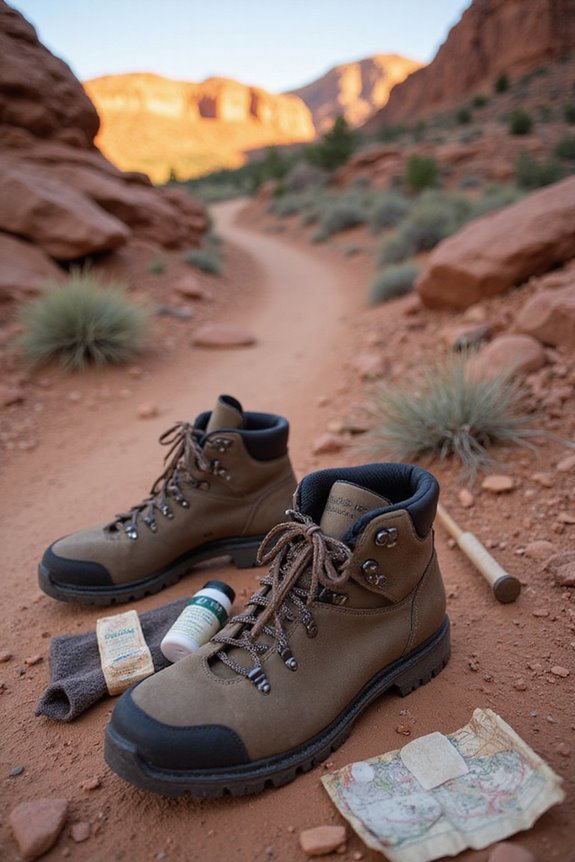
Now that we’ve got those fabulous socks sorted, let’s chat about making our hiking boots feel as cozy as our favorite pair of slippers. The secret lies in a steady break-in process! We should start by wearing our boots indoors for 30–60 minutes, flexing them gently on different surfaces. Gradually, we can take them outdoors on easy trails, keeping an eye out for any pressure points or pinching sensations.
Pay attention to boot flexibility as we ease into our adventures. Remember, our hiking joy is all about being comfortable and carefree—blisters are not our friends! So, let’s lace our boots securely, and take our time—after all, the journey starts with happy feet! Boots with a wide toe box are especially beneficial for preventing blisters and allowing natural toe movement during the break-in period.
Packing a Foot Care Kit for Hikes
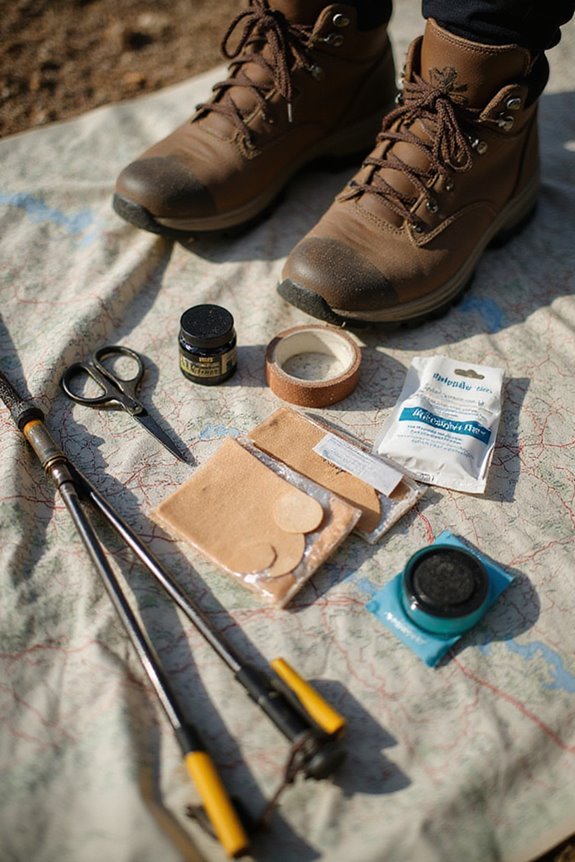
Have you ever found yourself miles into a hike, only to feel that dreadful pinch starting to form on your foot? We’ve been there too! That’s why packing a solid foot care kit is key for every adventure. To ward off blisters, let’s load up on moleskin pads and adhesive bandages—trust us, they’re lifesavers!
Don’t forget antiseptic wipes for deep cleaning cuts before they become a problem. We need our feet fit for freedom after all! For winter hikes, consider sizing up to accommodate thick hiking socks that provide crucial insulation in extreme temperatures. Regularly checking for hotspots during breaks is essential for blister prevention. With the right foot care gear, we can conquer any trail without our feet turning into drama queens. So let’s keep moving and relish every step!
Waterproofing and Boot Maintenance Supplies
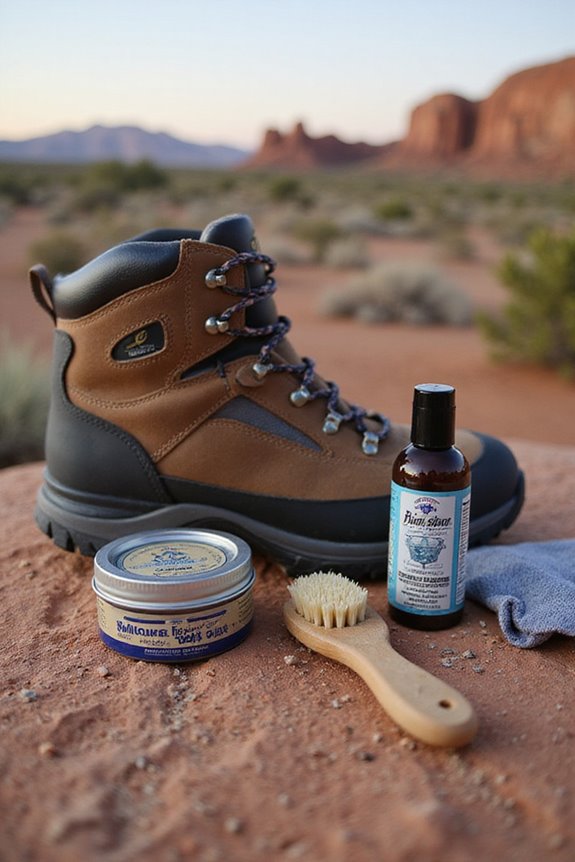
When it comes to keeping our hiking boots ready for the trails, a little love goes a long way! To guarantee our trusty footwear stands the test of wet adventures, we’ll want to pack waterproofing techniques and boot care supplies. A wax-based treatment, like beeswax, seals leather well, while silicone sprays work wonders on Gore-Tex® boots—keeping ’em breathable too!
Don’t forget a gentle brush for cleaning; dirt and grit can ruin our waterproofing game. After applying treatments, let’s dry our boots naturally—no one wants to crack leather over a campfire! By choosing the right products for our boot material, we can prolong their lifespan and guarantee our feet stay happy and dry out there. Regular maintenance can extend your waterproof hiking boots’ life for several years, making them a worthwhile investment for any adventurer. Let’s keep exploring!
Terrain and Weather Considerations for Footwear
While we all love the thrill of hitting the trails, the type of terrain and weather can really dictate what we should lace up before we head out. Whether we’re tackling rocky paths or smooth, well-groomed trails, our footwear needs to adapt! For challenging terrains, we need boots with stiff soles, high ankle support, and aggressive lug patterns—nothing says “adventure” like a boot that grips like a pro! On muddy days, waterproof options keep our feet dry and happy. And let’s not forget insulation for those icy hikes! With the right boots, we can conquer any trail thrown our way. So, let’s embrace terrain adaptation and guarantee we have strong weather resistance to enjoy our outdoor freedom!
Gaiters and Their Benefits for Hiking
Ready to elevate our hiking game? Gaiters are a must-have for any adventure, protecting our legs and boots from trail debris like stones, mud, and even sneaky insects. They provide a waterproof and breathable layer, especially valuable on slippery trails or when crossing streams. With various gaiter styles, we can find the perfect fit for our needs, whether we’re trudging through snow or maneuvering rocky paths. Plus, gaiter materials are designed to withstand the toughest terrains, keeping us dry and comfortable. Imagine striding confidently, knowing our feet stay warm and clean! So, let’s embrace the freedom of the trails and add gaiters to our pack. Trust me, our feet will thank us later!
Enhancing Boot Performance With Insoles
Insoles can be a game-changer for our hiking experience, transforming our trusty boots into a comfort zone on the trails. With the right insoles, we can enjoy incredible benefits, like improved support and alignment that keeps our feet happy over many miles. Custom insoles tailor-fit to our foot shape can even reduce the risk of pesky injuries like plantar fasciitis.
Envision cushioning that hugs our feet while we traverse rocky paths or slippery slopes! Plus, they help absorb shock, letting us hike longer without fatigue. Consider this: we conquer every elevation with stability and confidence! Slip in some quality insoles, and we’re on our way to a world of comfort and freedom, ready for the next adventure!
Load Distribution in Your Backpack for Optimal Comfort
When we hit the trails, understanding how to properly distribute the load in our backpacks can make all the difference in having a joyful journey or a backache-filled fiasco. We want to feel the freedom of the great outdoors, not be weighed down like pack mules! For comfort optimization, let’s aim for 80% of the weight on our hips and 20% on our shoulders. By packing heavy items closest to our backs, we maintain balance, preventing fatigue. Using load-lifting straps keeps our packs snug against us. And don’t forget that sternum strap—it’s our shoulder’s best friend! Ultimately, when we get our weight distribution just right, we can trek confidently and enjoy every breathtaking view along the way. Happy hiking!
Frequently Asked Questions
How Do I Choose the Right Hiking Boots for My Foot Type?
Did you know around 75% of hikers have unique foot arches? To choose hiking boots, we must consider our foot type and the terrain we’ll tackle, ensuring they offer the support and comfort needed for our adventures.
Can Hiking Boots Be Used for Casual Walking?
Yes, we can enjoy hiking boot versatility even for casual walking. With proper break-in and lacing, they offer decent comfort, though we might feel their bulkiness on smooth paths. It’s all about our personal preferences!
What Is the Average Lifespan of Hiking Boots?
Like an adventurous wanderer’s tale, our hiking boots might journey up to 2,400 km, depending on materials. As we spot replacement indicators—worn soles or leaks—we should embrace the freedom of new paths with fresh boots.
Are There Specific Care Tips for Leather Hiking Boots?
Taking care of our leather hiking boots is essential for adventures. We must focus on consistent leather conditioning and applying waterproof treatments. This’ll keep our boots in top shape, ensuring comfort and freedom on each hike!
How Should I Store My Hiking Boots When Not in Use?
When we tackle boot storage, we’re battling moisture control like knights against dragons! Let’s stash our boots in a cool, dry chamber, ensuring they stay fresh and ready for our next wild adventure!

